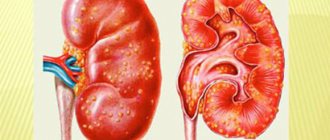Very often, children experience pathological malnutrition, which is accompanied by a small increase in body weight compared to the norm in relation to age and height. If this lag is more than 10%, malnutrition is diagnosed, which most often manifests itself before 3 years of age.
In pediatrics, this disease is considered as an independent type of dystrophy. Since malnutrition in young children is accompanied by very serious disorders in the body (failure of metabolic processes, decreased immunity, delayed speech and psychomotor development), it is important to promptly identify the disease and begin treatment.
Etiology
Hypotrophy in young children can accompany various diseases or develop as an independent disease. The most common etiological factors include the following:
- unbalanced diet;
- underfeeding or overfeeding the child;
- incorrectly selected mixtures;
- viral or infectious diseases;
- endocrine diseases;
- hereditary pathologies;
- disturbances in the gastrointestinal tract - incomplete absorption of nutrients;
- genetic predisposition of the fetus.
Hypotrophy at an early age can develop in a child even when consuming low-quality baby food. It should also be noted that malnutrition in newborns can develop both during artificial and breastfeeding. That is why it is very important for the mother herself to eat right and generally take care of her health.
Perinatal etiological factors for the development of fetal malnutrition are also distinguished:
- improper nutrition during pregnancy (intrauterine malnutrition);
- chronic illnesses of the mother both before pregnancy and during pregnancy;
- alcohol abuse, smoking;
- frequent stress, nervous tension.
The constitutional features of the mother herself can be added to this subgroup. If a pregnant woman's weight is no more than 45 kg, and her height is no more than 150 cm, there is a risk of developing fetal malnutrition.
Muscle atrophy - causes
Many factors can cause muscle atrophy:
Diets low in protein, fruits and vegetables can lead to decreased muscle mass. Muscle wasting can develop as a result of diseases that impair the body's ability to absorb nutrients. These include:
Cachexia is a complex metabolic condition that causes extreme weight loss and muscle wasting. Cachexia may develop as a symptom of another underlying condition, such as cancer, HIV, or multiple sclerosis. People with cachexia may experience loss of appetite or may experience unintentional weight loss despite eating large amounts of calories.
As we age, the body produces less proteins, which increase the growth of muscle fibers. A decrease in protein leads to compression of muscle cells and the development of sarcopenia. Sarcopenia affects up to a third of people over 60 years of age. In addition to reduced muscle mass, sarcopenia can cause the following symptoms:
- weakness;
- imbalance;
- difficulty moving;
- lower endurance.
Loss of muscle mass can be an inevitable result of the natural aging process, increasing the risk of injury and negatively impacting a person's overall quality of life.
Spinal muscular atrophy (SMA) is a genetic disease that causes loss of motor nerve cells and muscle wasting. There are several types of CMA, which fall into the following categories:
- SMA associated with chromosome 5 - occurs due to mutations in the SMN1 genes on chromosome 5. Mutations lead to a deficiency of motor neuron protein. SMA usually develops in childhood, but can appear at any age.
- SMA is not associated with chromosome 5.
Muscular dystrophy refers to a group of progressive conditions that cause muscle loss and weakness. Muscular dystrophy occurs when one of the genes involved in protein production is mutated. A person can inherit genetic mutations, but many occur naturally as the embryo develops.
- Amyotrophic lateral sclerosis (ALS) is also called Lou Gehrig's disease. The disease includes several types that damage the motor nerve cells that control muscles.
- Multiple sclerosis is a chronic condition that occurs when the body's immune system attacks the central nervous system, causing inflammation in the nerve fibers.
- Arthritis is inflammation of the joints that causes pain and stiffness. Arthritis limits a person's mobility, which can lead to muscle atrophy.
- Myositis is inflammation of the muscles. This condition causes muscle weakness and pain. People may develop myositis after a viral infection or as a side effect of an autoimmune condition.
- Poliomyelitis is an infectious disease that affects the nervous system. The disease causes flu-like symptoms and can lead to permanent paralysis.
- Injuries or conditions that damage the nerves that control muscles, leading to neurogenic muscle atrophy.
Symptoms
Symptoms of malnutrition: 1 - healthy child; 2 — malnutrition of the 1st degree; 3—grade 2 malnutrition; 4—grade 3 malnutrition
The clinical picture of fetal malnutrition manifests itself in the form of disruption of several systems at once. First of all, symptoms appear in the gastrointestinal tract:
- bloating;
- refusal to eat, poor appetite;
- nausea and vomiting;
- sudden weight loss.
As the disease develops, the clinical picture is supplemented by the following symptoms:
- poor sleep;
- impaired coordination of movements;
- decreased muscle tone;
- sudden mood swings in the child;
- emotional unstable background.
Also, against the background of such a clinical picture, the protective functions of the body sharply decrease in young children. Therefore, a child under one year old becomes easily vulnerable to any infections and viral pathological processes.
Symptoms
The first type of malnutrition occurs most easily. Since only the subcutaneous fat layer lags behind the norm. Moreover, the changes are minor. The child maintains his normal condition.
The weight characteristic for type 1 malnutrition averages twenty percent pathological changes. The second degree of hypotrophic changes already manifests itself with a number of pathological symptoms:
- the fat layer on the abdomen decreases;
- the fat layer on the face decreases.
Significant changes also affect the limbs. Their fat layer decreases. The weight loss is already more significant. Since the weight percentage is reduced even more.
Children with the second degree of malnutrition have certain clinical symptoms. These clinical symptoms relate to the following picture:
- muscles become flaccid;
- the child’s physical activity decreases;
- paleness of the skin;
- sleep disturbance;
- tearfulness;
- eating disorder.
Infants may burp frequently when feeding. Which also characterizes the disease. Children are characterized by unstable stools. Bradycardia may occur.
The heart sound in the second degree of hypotrophy is deaf. That is, the heart sound is muffled in some cases. Which is a fairly weighty argument in favor of the second type of malnutrition.
The most severe degree of malnutrition is the third type. In this case, a pronounced weight loss is observed. Weight loss is characterized by the absence of the subcutaneous layer. The child's weight symptoms decrease.
With the third degree of malnutrition, the child lags behind in physical parameters. The vital functions of the child’s body are disrupted. The following symptomatic complex is formed:
- unhealthy skin color;
- sagging and lack of elasticity of the skin;
- restless state of the child.
A child with severe malnutrition has an senile appearance. That is, his appearance differs from his age. And it does not correspond to the physiological age of the child. These include the following signs:
- flatulence leading to bloating;
- vomit;
- respiratory dysfunction;
- presence of dyspeptic symptoms.
Also, with the third degree of malnutrition, the child’s immunity decreases. The child is susceptible to various diseases. Often a child develops purulent diseases.
Read more about the disease on the website: bolit.info
Don't delay your visit to the doctor!
go to top
Classification
According to the international classification, the following types of malnutrition are distinguished:
- intrauterine (perinatal or congenital form);
- postnatal (acquired form);
- mixed type.
According to the degree of development, malnutrition in children can occur in the following forms:
- light;
- average;
- heavy.
Fetal hypotrophy of the 1st degree does not pose a significant threat to the health of the child. In this case, the deviation from the required weight is no more than 10–15% even with normal growth for this age.
The second degree means a deviation in weight of up to 30% and a growth retardation of 3–5 cm.
With third degree malnutrition, significant deviations in weight are observed - from 30% or more, and a significant retardation in growth. At this stage of development of the pathological process, malnutrition in a child may be accompanied by other diseases. The most common diseases that develop are:
- rickets;
- stomatitis;
- glossitis;
- hypoglycemia.
As practice shows, fetal malnutrition at the third stage almost always leads to the development of rickets.
Hypotrophy in newborns and young children: symptoms, classification, treatment – Supermama
Hypotrophy in children is chronic weight loss. Starting from the stage of intrauterine development, each child’s age has its own standards for height and weight, deviations from which in one direction or another indicate a change in nutrition.
Excess weight in children - paratrophy is no better than malnutrition. The issue of increasing the number of overweight children is very acute in world medical practice due to the fact that an increase in protein nutrition leads to rapid weight gain in a child in the first year of life.
They are at risk of developing metabolic syndrome in the future.
If the causes of excess weight lie in overeating (nutritional factor), then underweight is often associated not with the fact that the child does not eat enough, but with digestion problems.
Since 1961, WHO introduced the term “protein-energy malnutrition,” but in Russia, insufficient physical development, especially in newborns and young children, is referred to as malnutrition. The problem is aggravated by the fact that long-term deficiency of a number of food components, such as proteins, polyunsaturated fats, iron, and microelements leads to impairment of the child’s mental abilities.
Classification
Depending on the time of occurrence, malnutrition is divided into prenatal and postpartum. Prenatal (prenatal) or congenital malnutrition is nothing more than intrauterine growth retardation syndrome (IUGR). It develops when the blood supply to the fetus through the uterus and placenta is disrupted (fetoplacental insufficiency).
If fetal development indicators lag behind the standards by 14 days, they speak of 1st degree of developmental delay, by 3-4 weeks - 2nd degree, and by more than a month - 3rd degree.
There are 3 options for expressing delayed fetal development:
- The hypotrophic variant is characterized by body length and circumference of the head, chest and abdomen corresponding to the gestational age below normal;
- The hypoplastic variant reflects the proportional but reduced parameters of the child;
- With the dysplastic variant, developmental defects and fetal deformities are observed.
Postnatal (postpartum) malnutrition is divided into degrees in accordance with the lack of body weight. At grade 1, the lack of body weight is 10–20%;
- With grade 2 – 20–30%;
- At grade 3 over 30%.
The child's actual weight is compared with the weight calculated using tables of normal monthly weight gain. For example, body weight at birth is 3700 g, at the age of 3 months 5300 g. According to the table, the child should gain 600 g + 800 g + 800 g in 3 months, a total of 2200 g. Normal body weight at 3 months for this child should be 5900 g .
The mass deficit is 5900–5300, that is, 600 g, which corresponds to 10% according to the proportion formula:
- 5900 – 100%;
- 600 – 10%, therefore, the child has 1st degree malnutrition.
Causes
The causes of prenatal and postnatal malnutrition are different. The following causes are typical for fetal IUGR syndrome:
- Maternal factor - diseases of the cardiovascular, bronchopulmonary, urinary systems, smoking, alcoholism, drug use, malnutrition, insulin-dependent diabetes mellitus, multiple pregnancies, infertility and abortion in history, taking certain medications, chronic stress and other neuropsychiatric overload, past rubella, syphilis, cytomegalovirus infection.
- Placental causes - associated with the pathology of the placenta. Possible underdevelopment, inflammation, low attachment, premature detachment, early aging. In recent years, this has come to include antiphospholipid syndrome, that is, the formation of blood clots in the vessels of the placenta.
- Socio-biological factors are also considered as causes of congenital malnutrition. Occurs in young primigravidas aged 15–17 years, in single women giving birth without a husband, in those who live in the highlands;
- Hereditary causes are associated with chromosomal and gene abnormalities.
All these reasons directly or indirectly worsen uteroplacental blood flow, which disrupts fetal nutrition and malnutrition of newborns of varying degrees of severity.
Hypotrophy in young children has other causes:
- Exogenous - direct lack of basic food ingredients, malnutrition and problems that interfere with food intake. For example, swallowing problems due to disorders of the nervous system or malformations of the face and jaws;
- Endogenous - there are 3 groups of them:
- Problems with digestion, absorption and retention of food;
- Illness of a child when he needs increased nutrition (prematurity, chronic diseases of the pulmonary system, microbial and viral infections;
- Metabolic problems acquired from birth.
With malnutrition in children, metabolism progressively deteriorates, which ultimately leads to stress due to acidosis and cell destruction.
Liver function suffers, humoral immunity decreases. The breakdown of adipose tissue destabilizes the cell membrane. The body rearranges metabolic processes to direct energy to the brain. The entire digestive system suffers, the mucous membrane atrophies, the production of enzymes decreases, motility changes, and local immunity decreases.
Symptoms
Symptoms of malnutrition in newborns depend on the type of IUGR. It should be noted that even in modernly equipped perinatal centers, the mortality rate of newborns in the first 7 days of life in the case of severe syndrome despite treatment reaches 35%.
Children who have had IUGR have symptoms such as:
- Retarded physical development (60%);
- Delayed psychomotor development (40%);
- Cerebral palsy;
- Oligophrenia (12%).
Symptoms in the hypotrophic variant are less pronounced, the prognosis is more favorable, but susceptibility to infectious diseases and pneumonia in early childhood, especially up to one year, remains high.
A study of the long-term consequences of congenital malnutrition in newborns revealed symptoms of decreased intelligence at school age, neurological disorders, and a tendency to develop hypertension, coronary heart disease, and diabetes mellitus.
1st degree
With grade 1 malnutrition, the child experiences minor symptoms confirming that nutrition has been disrupted.
The fat layer disappears from the anterior abdominal wall, skin turgor and muscle elasticity decrease, regurgitation is observed, sleep is disturbed, anxiety and fatigue are noted.
At the same time, there is no growth retardation or deviations in mental development. The child remains prone to frequent colds.
2nd degree
When malnutrition is at level 2, the following symptoms appear.
Fat disappears from the entire body, except the cheeks, the skin and muscles are flabby, joints and bones are visible, the child has a decreased or no appetite, irregular bowel movements, and undigested food in the stool.
Due to vitamin deficiency, the growth of hair and nails is impaired, there are jams in the corners of the mouth, the child quickly overheats or cools down, colds are frequent and long-lasting, he is often capricious and restless.
3rd degree
The 3rd degree of malnutrition in a child is the most severe; if it is not treated, he will die. The main symptoms include the disappearance of fat from the child’s cheeks, atrophy of the skin and muscles, disruption of the heart and breathing, decreased blood pressure, growth retardation, mental retardation, and refusal to eat.
Pediatricians in practice use the calculation of the nutritional index for newborns and children up to one year old. This calculation is easy to do yourself. Measure the circumferences of the shoulder, thigh and lower leg, find the sum, and subtract the child’s height from it. Normally, in a child under one year old, the index is 25–30 cm. In case of malnutrition of the 1st degree, it is reduced to 10–15 cm, in case of the 2nd degree – below 10 cm.
Treatment
Fetal IUGR syndrome should begin to be treated during pregnancy. The goal of treatment is to improve uteroplacental blood flow. For this purpose, Curantil, Actovegin, vitamin and mineral complexes, including antioxidant vitamins, are used. Treatment includes proper nutrition, fresh fruits and vegetables in sufficient quantities, a protein diet, and dairy products.
In some cases, depending on the severity of the fetal condition and prognosis, the question of the advisability of continuing the pregnancy is decided.
It is not difficult to restore nutrition in case of 1st degree malnutrition. The children's consultation will make the necessary calculation of the amount of breast milk per day and one feeding. In case of hypogalactia, suitable breast milk substitutes will be prescribed, complementary feeding, juices and cottage cheese will be recommended . The frequency of feedings in such children should be increased to 7–8 per day.
For babies over one year of age, the diet includes cereals, fruits and vegetables. Prescription of drugs for grade 1 malnutrition is not required.
Stage 2 requires the need to adjust diet and feeding, balance nutrition, prescribe medication, which can be performed both at home and in the hospital.
Diet and nutrition must be age-appropriate; the regimen changes. Portions are reduced, but the frequency of meals becomes more frequent. Treatment is carried out with biological stimulants, digestive enzymes, vitamin and mineral complexes.
The presence of severe third degree malnutrition indicates that hospital treatment is indicated. Simply adjusting your diet is not enough. The baby receives complex infusion therapy and parenteral and enteral feeding through a tube.
Treatment of grade 3 malnutrition is aimed at maintaining and correcting the vital functions of the body and includes blood, plasma, glucose transfusions, and the administration of enzymes and hormones.
The fight against dehydration, electrolyte balance, and acid-base balance is being carried out.
The tube feeding diet includes a specially developed milk-protein mixture, devoid of lactose, but with the addition of fats, including PUFAs (Alfare). When removed from a serious condition, rickets and anemia begin to be treated.
Subsequently, an age-appropriate diet is prepared. During the period of convalescence, treatment is carried out with nonspecific immunomodulators.
Prevention
Prevention has always been and remains preferable and more economical than treatment. Prevention of malnutrition in children consists of adequate breastfeeding, timely introduction of supplementary feeding and complementary feeding, and proper care of the baby.
Oddly enough, but prevention must begin from the childhood of future parents.
A balanced diet, physical education and sports, work and rest schedule, sleep, avoiding stress, giving up bad habits, timely sanitation of foci of infection, personal and intimate hygiene, planned pregnancy and carrying it out under the supervision of a specialist in compliance with all recommendations is an effective prevention of complications and guarantee of the birth of a healthy child.
▼We RECOMMEND YOU TO STUDY▼
Source:
Hypotrophy in newborns and young children: symptoms, classification, treatment. Dystrophy in children (hypotrophy) Nutrition of children with malnutrition
The ecology and lifestyle of modern women lead to the fact that the development of the baby in the womb lags behind the norm. Fetal hypotrophy is a serious diagnosis that some expectant mothers face. The disease can affect the physical and mental state of the child in the future.
If detected in a timely manner, such a deviation does not pose a danger to the baby and mother. This is why it is necessary to regularly visit your doctor. If the disease is detected in the early stages, there will be no consequences for the child.
Women often hear this diagnosis at the beginning of pregnancy or in the 3rd trimester. Hypotrophy is a developmental delay of the fetus and deviation of fetometric indicators from the norm.
At each routine visit, the doctor measures the woman's abdominal circumference. But this is not enough to determine malnutrition. Using ultrasound, you can find out the length of the limbs, the circumference of the head, abdomen of the fetus, and the volume of amniotic fluid. All these indicators are called fetometric. And any deviation from them requires close attention to the child’s body in the womb.
Intrauterine growth retardation can be caused by various factors.
Causes of malnutrition
:
- poisoning of the body with nicotine, alcohol and drugs;
- sexual infections: , and others;
- (late toxicosis);
- hypertension and serious diseases of the cardiovascular system;
- diabetes;
- taking certain medications that do not allow beneficial nutrients and trace elements to reach the fetus;
- early placental maturation;
- pregnancy with two or more fetuses (multiple pregnancy);
- chromosomal abnormality;
- risk age of a woman (less than 17 years and more than 30);
- tight;
- heavy physical labor or working with pesticides;
- disorders of the endocrine system and hormonal levels;
- constant exposure to stress.
Source: https://3rdom74.ru/razvitie/gipotrofiya-u-novorozhdennyh-i-detej-rannego-vozrasta-simptomy-klassifikatsiya-lechenie.html
Diagnostics
If a woman undergoes a timely examination during pregnancy, fetal malnutrition will be detected at an early stage of development. If such a pathology is suspected, the pregnant woman is sent for an ultrasound examination and undergoes screening.
As for newborn children or young children, pathological developmental abnormalities will certainly be noticeable by a pediatrician during examination.
Diagnostic measures for suspected malnutrition in a child include the following:
- measuring head and abdominal circumference;
- measuring the thickness of the skin and fat.
Consultation with medical specialists of other profiles is also required:
- geneticist;
- cardiologist;
- neurologist;
- endocrinologist
Depending on the age of the child, instrumental diagnostics may be needed:
- ECG;
- Ultrasound of the abdominal organs;
- general and biochemical blood tests;
- coprogram.
Only on the basis of the tests obtained can the doctor finally establish a diagnosis and prescribe the correct course of treatment.
Hypotrophy in children, degrees, causes in newborns
Hypotrophy in children is a pathology that is associated with malnutrition of the baby, characterized by a discrepancy between age and height and weight gain. As a rule, pediatricians make this diagnosis for children under 3 years of age, mostly for newborns.
The danger of such a condition is that it entails various disruptions in the child’s body, including mental retardation.
Therefore, parents should be aware of this problem, react to its clinical manifestations in time and immediately consult a doctor.
Hypotrophy in children
The term malnutrition comes from two Greek words - hypo - lower, trophe - nutrition.
Reference! According to ongoing research, the deficiency state is observed with equal frequency in both boys and girls. It is noteworthy that half of the children with this diagnosis were born in the cold season.
From birth, the child begins to significantly gain body weight, all his organs are actively growing, and if the baby is not fed correctly, signs of malnutrition immediately appear.
Most often, this pathology develops due to a lack of calories and proteins in the child’s diet. Initially, a lag in body weight manifests itself in disorders of the gastrointestinal tract, as a result of which the absorption of nutrients is impaired.
In addition, the child may suffer from a lack of microelements and vitamins.
Causes of malnutrition in children
Hypotrophy can be caused by various factors of both the perinatal and postnatal stages of child development.
Intrauterine malnutrition may be associated with the following points:
- toxicosis;
- gestosis;
- fetoplacental insufficiency;
- premature birth;
- fetal hypoxia;
- intrauterine infection;
- mother's bad habits;
- stressful situations and frequent depression in the mother;
- insufficient nutrition of a woman during pregnancy;
- non-compliance with the daily routine during pregnancy;
- unfavorable environmental living conditions;
- work of the expectant mother in hazardous work;
- the mother has serious pathologies - diabetes mellitus, heart disease, nephropathy, hypertension, pyelonephritis.
Acquired malnutrition can be caused by:
- congenital, in particular chromosomal developmental abnormalities;
- enzymatic deficiency (lactose deficiency, malabsorption syndrome, celiac disease),
- diathesis;
- immunodeficiency state;
- unbalanced diet;
- regular malnutrition associated with pathologies of maternal breastfeeding;
- malnutrition due to low lactation or decreased volume of formula;
- strong and frequent regurgitation;
- maternal nutritional deficiency, as a result of which the milk composition becomes poor quality;
- presence of intestinal infection;
- severe pneumonia;
- frequent colds;
- tuberculosis;
- unsanitary living conditions for the baby and improper care for him - lack of walks in the fresh air, insufficient sleep, and so on.
It happens that there are several reasons for the development of malnutrition, then the pathology develops faster. Inadequate nutrition worsens the immune system, and this in turn makes it possible for frequent infectious diseases to occur, which provokes weight loss in the child and increases the manifestations of malnutrition.
How to recognize malnutrition in children
Diagnosis of pathology is based on the method of measuring the child’s body and its parts - body weight deficiency and slower growth rates relative to acceptable values.
We recommend: Laser therapy for adenoids in children
In addition, a biochemical blood test reveals:
- hypoalbuminemia - a decrease in albumin - an integral part of the blood;
- dysproteinemia – a failure in the balance between blood protein fractions;
- hypoglycemia – decreased glucose levels;
- hypocholesterolemia – lowering cholesterol levels;
- Dyslipilemia is a malfunction in lipid balance.
A urine test determines leukocyturia, excess ammonia, and ketone bodies. In a coprogram - a violation of intestinal digestion.
The doctor may also prescribe:
- Ultrasound of the abdominal organs;
- electrocardiogram or echocardiography;
- electroencephalogram;
- consultation of narrow specialists - genetics, cardiologist, neurologist and others.
Hypotrophy 1st degree and 2nd degree
The first degree of malnutrition most often occurs unnoticed by parents; in addition, the baby may have a thin physique, which has nothing to do with malnutrition. Only a doctor can diagnose stage 1 pathology.
Symptoms:
- sleep disturbance;
- poor appetite;
- pale skin;
- anxiety;
- thinness in the abdominal area;
- in rare cases, signs of rickets or anemia may be observed.
2nd degree parents can notice on their own:
- weight loss up to 30%;
- growth retardation up to 4 cm;
- lethargy, lethargy;
- poor appetite and frequent regurgitation;
- constipation and diarrhea;
- cold extremities;
- delay in psychomotor development;
- shortness of breath and tachycardia;
- frequent respiratory diseases;
- pronounced thinness.
In grade 3, the child’s condition becomes almost critical:
- weight deficiency more than 30%;
- growth retardation up to 10 cm;
- the bones are covered with skin;
- gray dry skin;
- tearfulness, apathy, drowsiness;
- loss of previously acquired skills;
- retraction of the fontanel - in infants;
- mental underdevelopment;
- the presence of chronic kidney or lung infections;
- cracks in the corners of the lips;
- stool disorder.
Treatment of malnutrition
Stage 1 malnutrition is treated on an outpatient basis, and if the weight loss is more than 30%, the child must be hospitalized.
The main therapeutic measures are aimed at:
- eliminating the causes that caused weight loss;
- enhanced baby nutrition;
- proper care;
- elimination of developed metabolic disorders.
If the child has a weakened sucking or swallowing reflex, nutrients are administered through a tube.
In some cases, drug therapy is indicated:
- vitamins;
- enzymes;
- adaptogens;
- anabolic hormonal drugs.
In critical condition, intravenous infusion of vitamins, glucose, saline solutions, and protein hydrolysates is indicated.
Possible complications and consequences
Complications of malnutrition are mainly associated with infectious diseases:
- pneumonia;
- otitis;
- prolonged and frequent colds;
- enterocolitis;
- sepsis;
- rickets.
Competent and timely treatment will completely eliminate the problem. Advanced forms of pathology can lead to death. According to statistics, mortality due to malnutrition is 30-50%.
Treatment
Treatment of the disease depends on the type of disease and the stage of development of the disease. If we are talking about intrauterine malnutrition (during pregnancy), then therapy is primarily aimed at the expectant mother herself. Treatment may include the following:
- balanced diet;
- taking medications to eliminate pathology;
- taking enzymes to improve digestion.
In most cases, if pathology is detected in the second or third trimester of pregnancy, treatment is inpatient.
Treatment of children (newborns and up to one year old) also takes place in a hospital. To prevent the child from developing muscle wasting, bed rest is prescribed. Complex therapy includes the following:
- food on a special diet;
- taking vitamin preparations;
- courses of special massage and exercise therapy;
- biological additives.
In addition, how the child will be cared for is very important. According to official statistics, malnutrition in children and during pregnancy is most often observed in socially disadvantaged families.
Signs
There are several stages of muscle wasting:
- The amount of subcutaneous tissue throughout the body decreases. A person loses up to 20% of body weight. He has pallor, weak appetite, muscle tone decreases;
- Subcutaneous tissue on the abdomen and chest practically disappears. The skin becomes gray, the muscles become flabby, and the liver increases in size. Mental health disorders and irritability occur;
- Severe wasting (cachexia) occurs when the patient loses 30% of muscle mass. The condition requires intensive therapy.
Common symptoms of muscle wasting include the following:
- Constant muscle pain;
- Weakness;
- Inability to perform normal movements;
- Significant loss of body weight.
If areas of muscle wasting are located symmetrically, this raises suspicion of myopathy or spinal amyotrophy. With progressive muscular dystrophy, relatively isolated wasting of the quadriceps femoris or biceps brachii is observed. If malnutrition is located in the distal limbs, we are talking about polyneuropathy (with impaired sensitivity and loss of reflexes in the distal limbs) or Steinert’s myotonic dystrophy.
Unilateral acquired isolated muscle wasting is always a consequence of damage to the root, plexus or peripheral nerve. Decisive for the topical diagnosis is the characteristic distribution of the process of malnutrition and sensory disturbances or prolonged inactivity of the muscle. Hypotrophy of the quadriceps muscle occurs with arthrosis of the knee joint and with sarcoma of the hip. Focal wasting of individual muscles or muscle groups, isolated and sometimes symmetrical, can slowly progress over many years. This is a sign of focal damage to the ganglion cells of the anterior horns or ischemia in the area of the blood supply of the artery.
Hypotrophy of the calf muscles often occurs. With progressive muscular dystrophy, sometimes in significantly hypotrophied muscles areas with intact muscle fibers are identified, which look like nodules. Doctors at the Yusupov Hospital distinguish them from a muscle roll, which is formed when the short head of the biceps brachii muscle is ruptured and is noticeable on the flexor surface of the shoulder.
Diet
Principles of diet therapy for malnutrition
The diet is prescribed only by the attending physician based on the individual characteristics of the patient and the stage of development of the disease:
- in the first degree - meals at least 7 times a day;
- in the second degree - 8 times a day;
- with the third - 10 times a day.
As for the list of products, they are chosen based on what the patient’s digestive system can digest.
Prevention
Preventative methods are especially important during pregnancy. It is very important for the expectant mother to eat well and in a timely manner, since the baby’s health depends on it. Also, during pregnancy, a woman should undergo regular examinations to ensure timely detection of pathology.
Today, the best prevention of malnutrition in newborns is careful pregnancy planning.
For newborns, preventive measures are as follows:
- the baby’s nutrition should be complete and only of the best quality;
- Weight gain and growth should be constantly monitored;
- the child must undergo a timely examination by a pediatrician;
- Complementary foods should be introduced gradually, starting with small doses;
- products must have all the necessary vitamins and minerals.
If you experience the symptoms described above, you should immediately consult a doctor and under no circumstances self-medicate. Delay, in this case, can result in the child’s disability or death.












